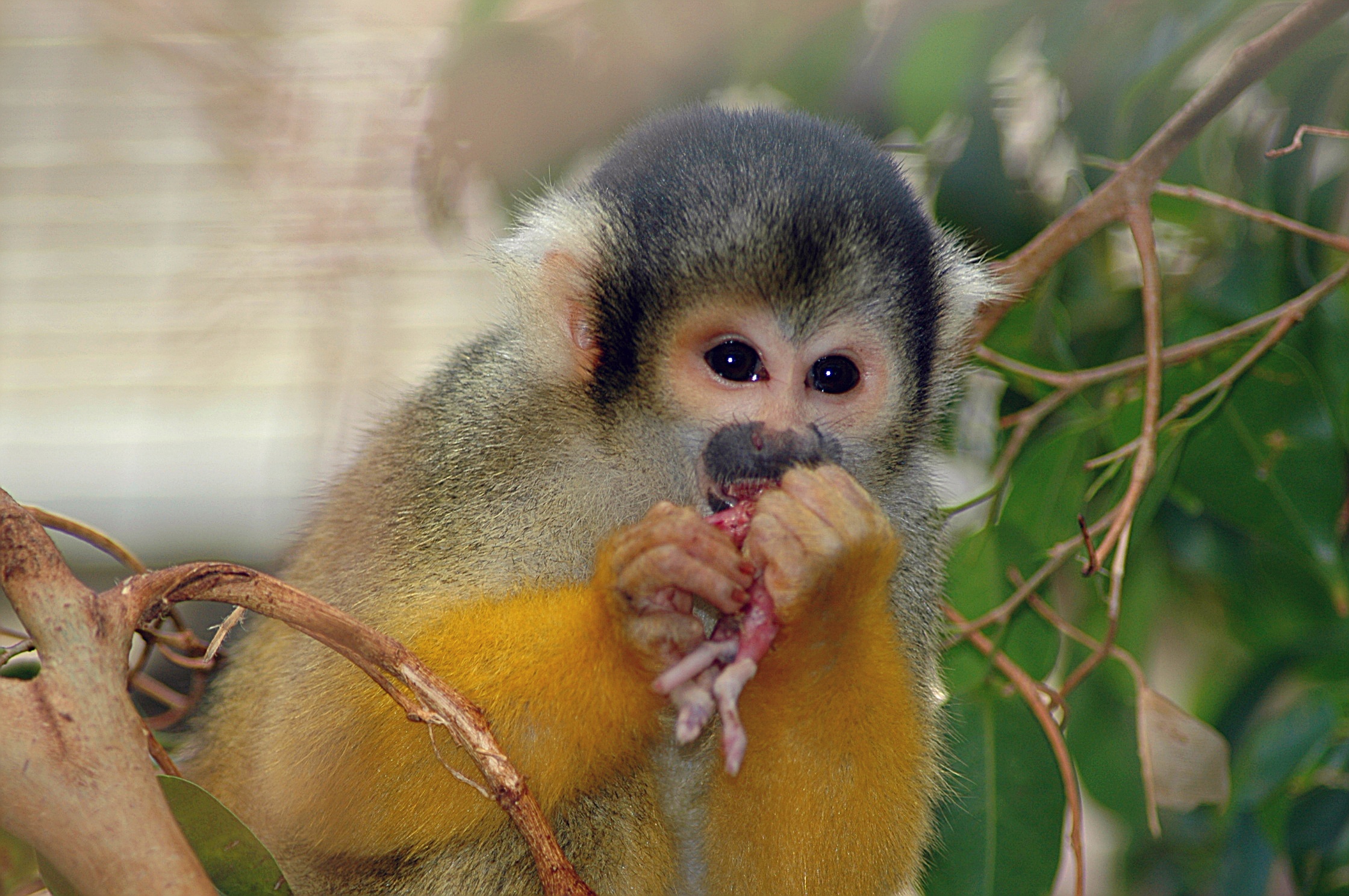- Haplorrhini
Taxobox
name = HaplorrhinesMSW3 Groves|pages=127-184]
fossil_range = EarlyEocene – Recent

image_width = 250px
image_caption =Common Squirrel Monkey ("Samiri sciureus")
regnum =Animal ia
phylum = Chordata
classis =Mammal ia
ordo =Primate s
subordo = Haplorrhini
subordo_authority = Pocock, 1918
subdivision_ranks = Families
subdivision =Tarsiidae Cebidae Aotidae Pitheciidae Atelidae Cercopithecidae Hylobatidae Hominidae The haplorrhines, the "dry-nosed" primates (the Greek name means "simple-nosed"), are members of the Haplorrhini clade: the
prosimian tarsier s and all of the truesimian s (themonkey s and theape s, including humans).The
omomyid s are an extinct group of prosimians, believed to be more closely related to thetarsiers than to any strepsirrhines, and are considered the most primitive haplorrhines.Haplorrhines are considered to be less primitive than the
strepsirrhine "wet-nosed" primates (whose Greek name means "curved nose"), the other suborder of primates. The haplorrhines, includingtarsiers , have all lost the function of the terminal enzyme which manufactures vitamin C, while the strepsirrhine prosimians, like most other orders of mammals, have retained this enzyme and the ability to manufacture vitamin C. [ Am J Phys Anthropol. 1987 May;73(1):65-70. Vitamin C biosynthesis in prosimians: evidence for the anthropoid affinity of Tarsius. Pollock JI, Mullin RJ. [PMID 3113259] ] The haplorrhine upper lip, which has replaced the ancestralrhinarium found in strepsirrhines, is not directly connected to their nose or gum, allowing a large range of facial expressions. Their brain to body ratio is significantly greater than the strepsirrhines, and their primary sense is vision. Unlike the strepsirhines, haplorrhines have a post-orbital plate. Most species are diurnal (the exceptions being the tarsiers and thenight monkey s) and havetrichromatic color vision . Their hands and feet are more generally adapted, with specialization only for locomotion, such as the hooked hands common togibbon s andorangutan s, or the human bipedal feet.All of the simians have a single-chambered uterus; tarsiers have a bicornate uterus like the strepsirrhines. Most species typically have single births, although twins and triplets are common for
marmoset s andtamarin s. Despite similar gestation periods, haplorrhine newborns are relatively much larger than strepsirrhine newborns, but have a longer dependence period on their mother. This difference in size and dependence is credited to the increased complexity of their behavior and natural history.Classification and evolution
Haplorrhini and its sister clade, Strepsirrhini ("wet-nosed" primates), parted ways about 63 million years ago (mya). Approximately 5 million years later (58mya), only a short time afterward from an evolutionary perspective, the infraorder
Tarsiiformes , whose only remaining family is that of the tarsier (Tarsiidae ), branched off from the other haplorrhines. This could explain why the prosimian tarsiers show characteristics which once caused them to be grouped with the strepsirrhines.The remaining clade (Simiiformes [formerly Anthropoidea] ) is divided into two parvorders:
Platyrrhini (theNew World monkeys ) andCatarrhini (theOld World monkeys andape s). The New World monkeys split from the Old World about 40 mya, while the apes diverged from the Old World monkeys about 25 mya. The current theory has the ape/monkey split happening in Africa. However, the recent discovery of three newanthropoid fossil s ("Bugtipithecus inexpectans ", "Phileosimias kamali " and "Phileosimias brahuiorum ") inPakistan 'sBugti Hills is causing some scientists to revise this thinking.In the cladist perspective of daughter groups nested within ancestral groups, humans and extinct bipedal humanoids, (including
australopithecine s, "Kenyanthropus platyops " and a few others) -are grouped together in the tribeHominini . Hominines are classed together with knuckle-walking apes (formerly known aspongid s) and are collectively referred to asgreat ape s [Hominidae] because they each possess all the traits indicative of that clade. Similarly, all apes, large or small, living or extinct, (including humans) still share all the definitive biological traits of Haplorrhini in general, and Catarrhini specifically, and are members of each of those clades also.
* ORDER PRIMATES
** SuborderStrepsirrhini : non-tarsier prosimians
** Suborder Haplorrhini: tarsiers, monkeys and apes
*** Infraorder Tarsiiformes
**** Family Tarsiidae: tarsiers
*** Infraorder Simiiformes
**** Parvorder Platyrrhini: New World monkeys
***** FamilyCebidae : marmosets, tamarins, capuchins and squirrel monkeys
***** FamilyAotidae : night or owl monkeys (douroucoulis)
***** FamilyPitheciidae : titis, sakis and uakaris
***** FamilyAtelidae : howler, spider and woolly monkeys
**** ParvorderCatarrhini
***** Superfamily Cercopithecoidea: Old World monkeys
****** Family Cercopithecidae
***** Superfamily Hominoidea: apes
****** Family Hylobatidae: lesser apes (gibbons)
****** Family Hominidae: great (large) apes including humansReferences
* "Primate Taxonomy" (Smithsonian Institute Press, 2001),
Colin Groves (ISBN 1-56098-872-X)
* "Primates in Question" (Smithsonian Institute Press, 2003), Robert W. Shumaker & Benjamin B. Beck (ISBN 1-58834-176-3)
* [http://portals.conservation.org/downloads/storedfile/Document/0x8f66917c80b3f44f979766ceaf90fb62.pdf Neotropical Primates 10(3)]
Wikimedia Foundation. 2010.
